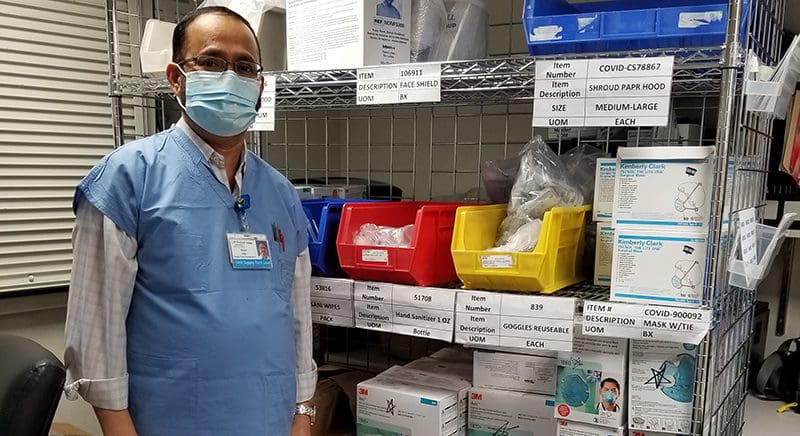Highlights | When supplies are low
- The Supply Chain team works around the clock to stock UW Medicine’s hospitals.
- This includes every item used for patient care except for medications.
- Supply Chain helped distribute and conserve PPE during the COVID-19 pandemic.
“Harborview is a hospital people trust,” says Supply Chain lead Alwyn Lobo.
The Supply Chain team works around the clock to support that reputation — and all the teams at Harborview, from patient care to environmental services.
Every item that is used for patient care, except for pharmaceuticals like medications, Supply Chain manages and distributes. The scale of distribution for a hospital as big as Harborview is an enormous undertaking.
Their job got even more complicated when, nationally, COVID-19 affected the supply for personal protective gear (PPE) and other medical supplies.
Reacting to the initial panic
Around the same time that toilet paper started disappearing off the shelves at grocery stores, PPE supplies started running low at Harborview. Teams wanted to make sure that their supplies were stocked to protect their patients and staff in preparation of a surge and were requesting masks, gloves and sanitizers at a higher rate than they were going through.
The surplus in supply requests started affecting the equilibrium of distribution.
So, in addition to reviewing centralized inventories in locations such as the Medical Stores department; Supply Chain ran a check on all units to validate how much supply the hospital really had. They went from unit to unit tallying supplies and recording an accurate inventory number.
The Infection Prevention team also made recommendations for PPE and helped adjust supply numbers and deliveries to meet the needs of every department.
“We wanted to take the stress of supplies away from hospital staff,” says Lobo. “We provided the needed quantity of supplies and would replenish every morning. If they got more patients in their unit, all the charge nurse needed to do was call and we would deliver.”
But really, what he says made the biggest difference was creating relationships with charge nurses and supply requestors based on trust and good communication.
Working through the challenges
After the initial panic for supplies, there were still day-to-day challenges. Sometimes shipments were late or multiple units asked for immediate deliveries of the same product. The Supply Chain managers worked with leadership and Infection Prevention teams to help triage those requests and make sure the supplies went to the units that needed them most.
Even during the most stressful times, Lobo says that his team excels at teamwork.
They work together to address problems, prevent product waste, and label and pack items for easy access. Even though they are on the periphery of patient care, their jobs have direct impact on the patient experience, and the team does their best to make supply access the least stressful part of a front-line worker’s day.
A family in healthcare
Lobo’s wife and son also work in healthcare. He says that before COVID-19 they used to hike together, but now, most of the time they spend talking about COVID-19 and sharing how they are each helping patients.
The stress of working in healthcare during a pandemic can take an emotional toll, but Lobo says he tries not to worry.
“I am helping people and doing my job right,” says Lobo. “If someone is happy or well because of my job, then it’s worth any personal expense.”



